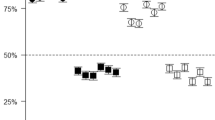Abstract
The purpose of this study was to teach children fractiondecimal equivalence using the respondent-type training procedure and test for any emergent generalization. In the first experiment, subjects were respondently trained on the conditional discriminations; A1→B1, A2→B2, and tested B1-A1, B2-A2. Subjects were then trained on the conditional discriminations C1→B1, C2→B2 and tested B1-C1, B2-C2. Subjects were subsequently tested for the emergence of the untrained relations A-C and C-A. When subjects were presented with the Stimulus A1 they observed 1/4 and when subjects were presented with A2 they observed 2/4. When subjects were presented with B1 they observed a circle with the upper left quarter shaded and when subjects were presented with B2 they observed a circle divided into four quarters with the upper half shaded. When subjects were presented with C1 they observed 0.25 and when subjects were presented with C2 they observed 0.50. Experiment 2 was identical to Experiment 1 except that subjects were administered three generalization tests. In Generalization Test Number 1, the Stimuli A1, A2, C1, and C2 served as samples and shapes not seen in training but with the same shaded areas served as comparison stimuli. Generalization Test No.2 was identical to the previous test, except that the comparison stimuli consisted of a shape not seen in training and the shaded area was altered. Generalization Test No. 3 was identical to the previous two tests except that the comparison stimuli were altered in that the number of shaded and unshaded areas was increased. Experiment 3 was identical to Experiment 2 except that an extra generalization test was added to the experiment. This test was identical to Generalization Test No. 3 of Experiment 2, except that the shaded areas were contiguous with each other.
In Experiment 1, subjects were successful on all equivalence
Similar content being viewed by others
References
BARNES, D. (1994). Stimulus equivalence and relational frame theory. The Psychological Record, 44, 91–124.
BARNES, D., & KEENAN, M. (1993). A transfer of functions through derived arbitary and non-arbitary stimulus relations. Journal of the Experimental Analysis of Behaviour, 59, 61–81.
BAROODY, A. J., & HUME, J. (1991). Meaningful mathematics instruction: The case of fractions. Remedial and Special Education, 12, 54–68.
BELL, A. (1993). Principles for the design of teaching. Educational Studies in Mathematics, 24, 5–34.
FIELDS, L., & VERHAVE, T. (1987). The structure of equivalence classes. Journal of the Experimental Analysis of Behavior, 48, 317–332.
HAYES, S. C. (1991). A relational control theory of stimulus equivalence. In L. J. Hayes & P. N. Chase (Eds.), Dialogues of verbal behavior (pp.19–40). Reno, NV: Context Press.
HAYES, S. C., BARNES-HOLMES, D., & ROCHE, B. (in press). A post-Skinnerian analysis of human language and cognition. New York: Plenum.
LEADER, G., & BARNES-HOLMES, D. (in press). Matching-to-sample and respondent-type training as methods for producing equivalence relations: Isolating the critical variable. The Psychological Record.
LEADER, G., BARNES, D., & SMEETS, P. M. (1996). Establishing equivalence relations using a respondent-type training procedure. The Psychological Record, 46, 685–706.
LYNCH, D. C., & CUVO, A. J. (1991). Stimulus equivalence instructions of fractiondecimal relations. Journal of Applied Behavior Analysis, 28, 115–126.
MACE, F. C. (1994). Basic research needed for stimulating the development of behavioral technologies. Journal of the Experimental Analysis of Behavior, 61, 529–550.
MACKAY, H. A. (1985). Stimulus equivalence in rudimentary reading and spelling. Analysis and Intervention in Development Disabilities, 5, 373–387.
MACKAY, H. A., & SIDMAN, M. (1984). Teaching new behaviours via equivalence relations. In P. H. Brooks, R. Sperber, & C. MacCauley (Eds.), Learning and cognition in the mentally retarded (pp. 493–513). Hillsdale, NJ: Erlbaum.
SIDMAN, M. (1971). Reading and auditory-visual equivalence. Journal of Speech and Hearing Research, 14, 5–13.
SIDMAN, M. (1980). A note on the measurement of conditional discrimination. Journal of the Experimental Analysis of Behavior, 33, 285–289.
SIDMAN, M. (1986). Functional analysis of emergent and verbal classes. In T. Thompson & M. A. Zeiler (Eds.), Analysis and interaction of behavioral units (pp. 213–245). Hillsdale, NJ: Erlbaum.
SIDMAN, M. (1987). Two choices are not enough. Behavior Analysis, 22, 11–18.
SIDMAN, M. (1994). Equivalence relations: A research story. Boston, MA: Authors Cooperative.
SIDMAN, M., & CRESSON, O., Jr. (1973). Reading and crossmodal transfer of stimulus equivalence in severe retardation. American Journal of Mental Deficiency, 77, 513–523
SMEETS, P. M., LEADER, G., & BARNES, D. (1997). Establishing stimulus classes in adults and children using a respondent-type training procedure: A follow-up study. The Psychological Record, 47, 285–308.
STROMER, R., MACKAY, H. A., & STODDARD, L. T. (1992). Classroom applications of stimulus equivalence technology. Journal of Behavioral Education, 2, 225–256.
Author information
Authors and Affiliations
Corresponding author
Additional information
This research was conducted as part of Geraldine Leader’s doctoral research program under the supervision of Dermot Barnes-Holmes. These data were presented at the Symposium on Stimulus Equivalence at the Annual European Meeting of the Experimental Analysis of Behavior Group, London, April 1998.
Rights and permissions
About this article
Cite this article
Leader, G., Barnes-Holmes, D. Establishing Fraction-Decimal Equivalence Using A Respondent-Type Training Procedure. Psychol Rec 51, 151–165 (2001). https://doi.org/10.1007/BF03395391
Published:
Issue Date:
DOI: https://doi.org/10.1007/BF03395391




